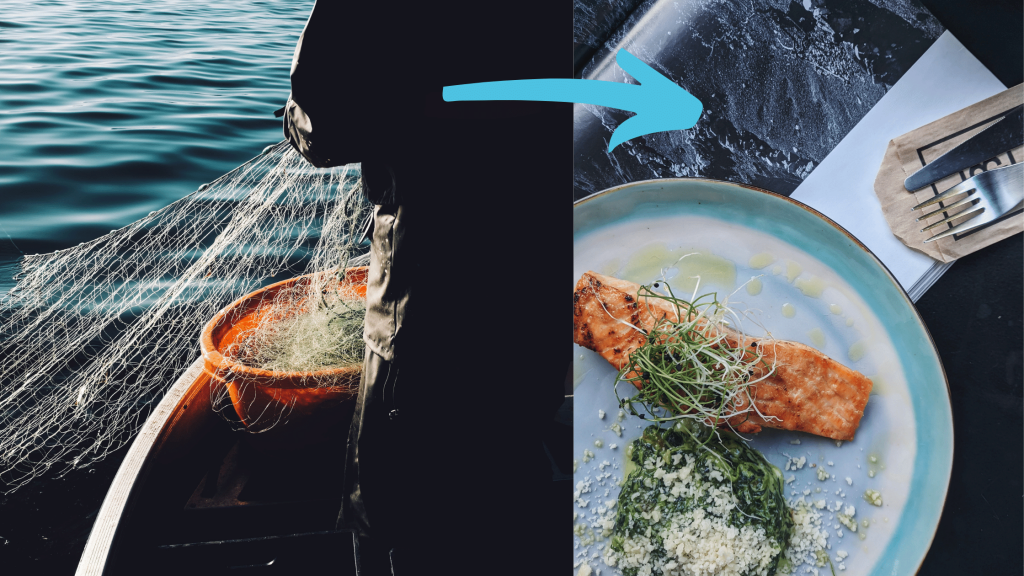Seafood goes through many steps along its journey from boat to plate, which makes tracing products along the seafood supply chain very complex.
Seafood is at risk of illegal practices, fraud, and mislabelling as it travels through the supply chain. This results in the end consumer often having no certainty about where their seafood came from – if it was caught by companies exploiting human labour, if it was fished sustainably, and if it’s correctly labelled. Seafood traceability gives that certainty to consumers, and it improves food safety, proves legality, and verifies sustainability claims, making it possible for everyone along the supply chain to know their fish.
Vericatch was founded with the goal of creating a positive impact on the fishing industry and our environment, so we were proud to be amongst 26 stakeholders who recently called upon the Canadian government to commit to a timeline and plan to fulfill their mandate to implement boat-to-plate traceability for seafood in Canada. This initiative was led by SeaChoice and Oceana Canada and included other organizations such as FishWise, Organic Ocean, and Sobeys.
Sayara Thurston, Seafood Fraud Campaigner at Oceana Canada said: “Eighty percent of the seafood we eat is caught in other parts of the world – including regions that use forced labour and illegal fishing practices. Canadians, including retailers, want to know where and how their seafood is caught, and they want the federal government to put a robust boat-to-plate traceability program in place to prevent Canada from contributing to these devastating practices.”
What is traceability?
Seafood traceability is the ability to access and track information about seafood products throughout the supply chain. That means being able to identify and verify key data elements (KDEs) about a product from the point of harvest through to the end consumer, including all the movements, transactions, and treatments it undergoes along that journey. As well as increasing visibility along the supply chain, traceability supports the industry overall in striving for higher sustainability and responsibility standards through incremental change.
The benefits of seafood traceability
Consumers want to know that their seafood is produced and harvested sustainably and businesses want to be confident that they’re purchasing socially responsible and sustainable products. In a recent poll on Americans’ views on climate change from the Walton Family Foundation, the results showed that 80 percent of respondents expected stores and restaurants to ensure that they are selling legally caught seafood with no human rights or labour violations. Other research shows that “38 percent of the consumers surveyed possessed a willingness to reward companies they perceived as responsible.” Traceability gives that reassurance.
And traceability has other far-reaching benefits, it also:
- Mitigates the reputational risk of seafood fraud
- Builds brand loyalty and earns consumer trust
- Turns compliance into a revenue-generating opportunity over time
- Reduces wastage through enhanced inventory management
- Tracks sustainable and sourcing metrics over time
- Ensures governments have more data to better manage their resources
Our CEO, Julian Hawkins, adds that “the fishing industry needs to protect itself and the ocean to remain viable – traceability makes that possible.”
How to implement traceability
Traceability is not an all-or-nothing proposition. The journey towards full traceability can begin from wherever your business is today. At a minimum companies can track their product on a “one up, one down” basis, at a maximum full traceability across the supply chain allowing everyone along the supply chain to see all the KDEs.
According to a 2020 report “the main obstacles to industry-wide traceability are a lack of interoperability between companies because of system incompatibility, poor data capture and management, and traceability gaps in the supply chain.” In 2017 the Global Dialogue on Seafood Traceability (GDST) was formed to create global industry standards for seafood traceability including internationally agreed-upon KDEs for seafood products and technical specifications for interoperable traceability systems.
When implementing traceability solutions, challenges can include encouraging suppliers, distributors, and harvesters along the supply chain to track relevant KDEs. It’s also important to ensure that data is centralized so users only have to go to one source for everything they need. Finally, it’s important to ensure that the data being tracked is interoperable. Standardized KDEs and interoperable systems mean that everyone using them is tracking the same information and working from the same data source. When you factor in that implementing a traceability system that adheres to the GDST standards “could double the profit margin of fish processors while reducing investors’ risks” (Planet Tracker), then overcoming reluctance along the supply chain becomes worth it.
Why implement seafood traceability?
Seafood is the most globally traded food commodity in the world. A recent Guardian study demonstrates how vast seafood fraud is globally: “of 44 recent studies of more than 9,000 seafood samples from restaurants, fishmongers and supermarkets in more than 30 countries found that 36% were mislabelled.”
Traceability can combat that fraud by making it easier to keep each part of the supply chain distinct and documented. This has additional trickle-down effects including making it simpler to complete government-mandated activities, like completing catch reports and export documents.
Traceability also streamlines and automates communication throughout the supply chain – ensuring consistency and validity of information. This offers new data and makes it easier to see pain points and act on them. For example, traceability can show where a product is routinely held up or which supplier relationships may need to be reassessed.
Finally, traceability can also prevent food-borne illness outbreaks, make mass recalls easier, and helps protect producers, fisheries, suppliers, and retailers from potentially crippling legal costs. And you can’t discount the competitive edge traceability gives your business when it comes to consumers wanting to know where their food comes from.
Interested in getting started implementing traceability for your company? Contact us for more information about KnowYour.Fish, our leading traceability product that follows the GDST standard for interoperability.



